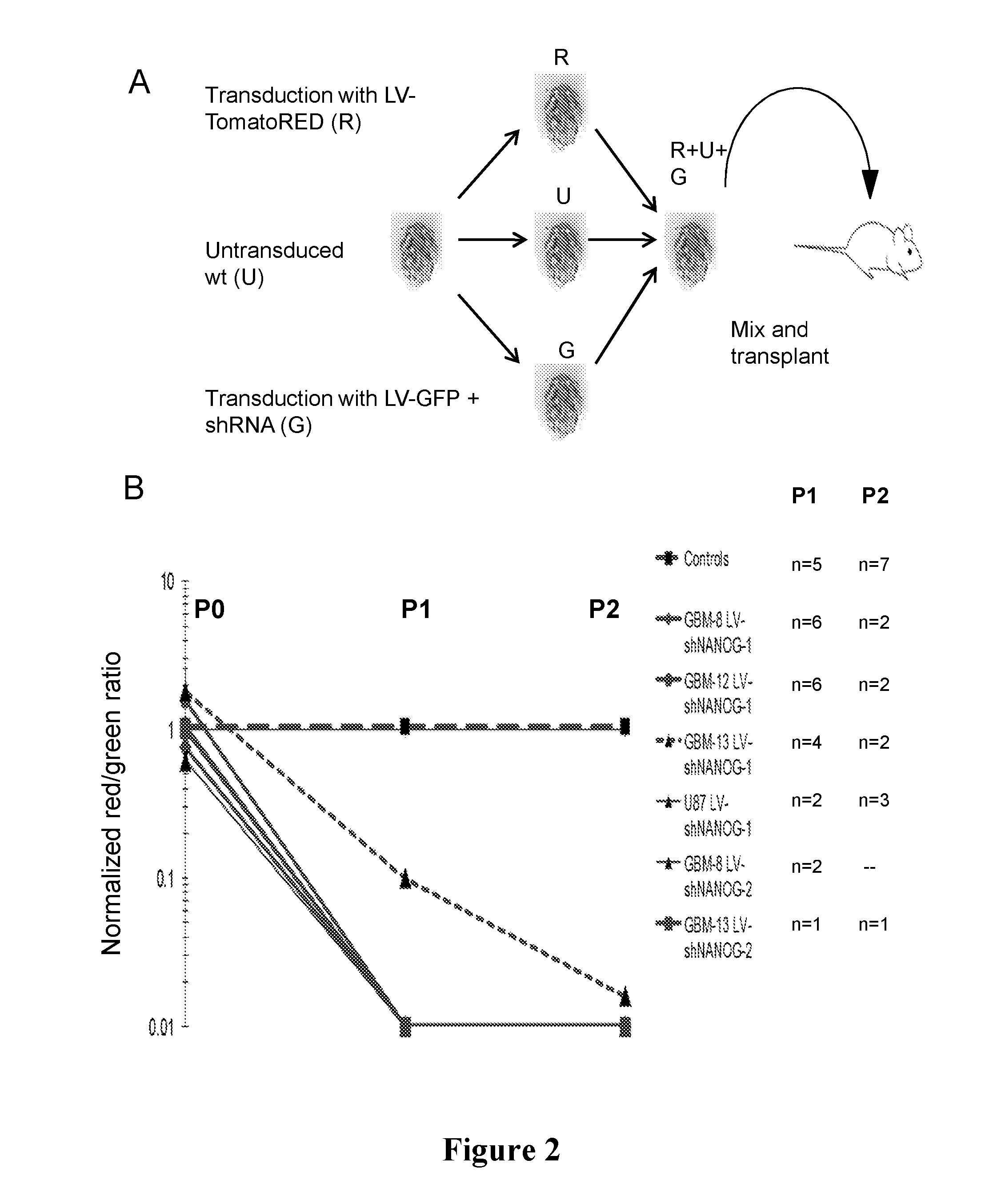Uses of NANOG inhibitors and related methods
a technology of nanog inhibitors and inhibitors, which is applied in the direction of antibody medical ingredients, peptide/protein ingredients, peptide sources, etc., can solve the problems of not being able to know if and routinely curative surgery, and achieve the effect of preventing resistan
- Summary
- Abstract
- Description
- Claims
- Application Information
AI Technical Summary
Benefits of technology
Problems solved by technology
Method used
Image
Examples
example 1
Expression of Nanog / Nanogp8 in Gbms
[0143]To test for the presence in GBMs of the two NANOG-encoding transcripts, we assayed for NANOG and NANOGP8 mRNAs (together referred as NANOG / P8) by quantitative RT-PCR, normalizing the values with those of TBP and βACTIN. NANOGP8 encodes NANOG protein with only 2 or 3 amino acid changes in comparison with each of the NANOG alleles. In addition to NANOG and NANOGP8 there are 10 non-coding NANOG pseudogenes. Their sequences are not recognized by the PCR primers used here.
[0144]All primary GBMs (gliomas WHO grade IV), lower grade astrocytomas and oligodendrogliomas (gliomas WHO grade III and II) tested expressed NANOG / P8 albeit to different levels (FIG. 1).
[0145]The results show that all brain tumors tested express NANOG and NANOGP8 mRNAs.
[0146]This provides evidence that all GBM cells express NANOG-encoding genes, and that NANOG is present and active in, but not restricted to, GBM stem cells.
example 2
Nanog Function Modulates Gbm Clonogenicity and Proliferation In Vitro
[0147]To test for the function of NANOG we have used two independent shRNAs expressed from replication incompetent lentivectors: shNANOG-1 (SEQ ID NO: 11) which targets the 3′UTR in a GFP+ lentivector and shNANOG-2 (SEQ ID NO: 12) which targets exon 4, with 50-70% efficiencies for mRNA degradation and 80-90% for protein. Each of these shRNAs inhibits both NANOG and NANOGP8. This strategy ensures the targeting of all NANOG encoding genes. Indeed, Western blot analyses showed that Kamiya rabbit#PC-102 antibody identified the endogenous and exogenous 42kD NANOG protein in U87 cells and that NANOG knock-down (kd) led to a near complete loss of endogenous NANOG protein.
[0148]NANOG kd was first performed in gliomaspheres. Single-cell clonogenic assays over 2 weeks showed that NANOG kd reduced the number of GFP+ gliomaspheres by 20-80%, as compared with control parental lentivectors. NANOG is thus required for normal clon...
example 3
Role of Nanog in Tumorigenicity and Tumor Growth In Vivo
[0151]To test for the role of NANOG in vivo, we used the novel in vivo red / green assay in which tumor cells that are differently and indelibly marked compete within a tumor environment. Cancer cells comprising equivalent populations of transduced cells expressing different fluorescent proteins (see above) are mixed in xenografts in immunocompromised mice, thus allowing for competition in vivo (FIG. 2A). The grown tumor is then isolated, cells dissociated, an aliquot is subjected to FACS quantification, and the rest re-injected into a new host, repeating the cycle as long as required. Here we have extended this assay to use it in orthotopic intracranial xenografts with primary GBM cells.
[0152]Injection of 105 GBM cells comprising mixed populations as described above showed that three patient-derived GBMs (GBM-8, GBM-12 and GBM-13) and U87 cells showed a rapid and massive loss of GFP+ cells expressing NANOG shRNAs in vivo, within...
PUM
| Property | Measurement | Unit |
|---|---|---|
| temperature | aaaaa | aaaaa |
| volume | aaaaa | aaaaa |
| resistance | aaaaa | aaaaa |
Abstract
Description
Claims
Application Information
 Login to View More
Login to View More - R&D
- Intellectual Property
- Life Sciences
- Materials
- Tech Scout
- Unparalleled Data Quality
- Higher Quality Content
- 60% Fewer Hallucinations
Browse by: Latest US Patents, China's latest patents, Technical Efficacy Thesaurus, Application Domain, Technology Topic, Popular Technical Reports.
© 2025 PatSnap. All rights reserved.Legal|Privacy policy|Modern Slavery Act Transparency Statement|Sitemap|About US| Contact US: help@patsnap.com



